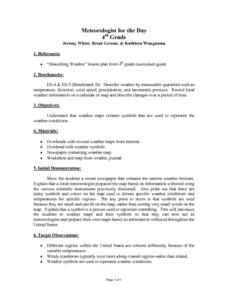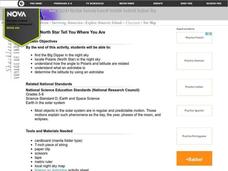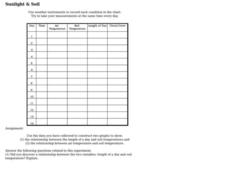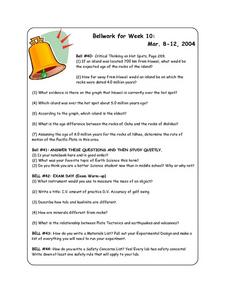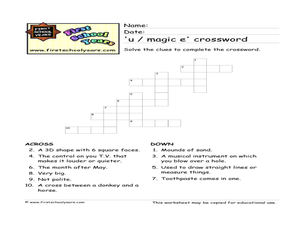Curated OER
Mercalli Scale Illustrated
Students study the Mercalli Scale and analyze how it is used to rate earthquakes. They construct a booklet with drawings that represent each rating of the scale. They study why engineers develop rating scales for earthquakes.
Curated OER
Rolling Down Hill
Students perform an experiment, collect, and analyze data of a rolling marble down a ramp. They report results after they complete their experiment. Students are assessed in science and writing.
Curated OER
Money Bags
First graders identify coins and their value. Using a mixed set of pennies, nickels, dimes, and quarters, they sort the coins and identify the name of each coin and the value of one coin in each set. As the teacher announces a given...
Curated OER
Math: Gears and Wheels
Twelfth graders solve problems involving linear and angular speed. Using information about a compact disc, they solve the problem using multiple rates and conversion factors. Students also solve additional problems involving bicycle...
Curated OER
North Pole Tag
Students review the proper way to chase, flee and dodge others in a game of tag. As a class, they pretend they are on the North Pole acting as grinches, reindeer and elves. They play the game practicing different locomotor skills.
Curated OER
Changes In Matter, "The Big Chill"
Third graders investigate why ice cream does not go through any chemical changes when it is exposed to physical changes. They describe the three states of matter in either written or verbal form. Then students experiment with ice cream...
Curated OER
Biocomplexity Lab Activity: Density and Buoyancy of
Students investigate how the density of water changes the buoyancy of
water. Students create a hypothesis about what will happen when placing the
egg into the water.Students can research online different bodies of water (The Red Sea, The...
Curated OER
Meteorologist for the Day
Fourth graders examine the symbols used on weather maps. They analyze a newspaper weather forecast and identify and discuss the various symbols used on the map. Next, they prepare a weather map for their own city using the symbols...
Curated OER
Matter & Subatomic Particles
Seventh graders divide into small groups to construct several models. Each group builds with an accompanying chart showing the colors of gumdrops used for the protons, electrons, and neutrons.)
Curated OER
Noise Underwater
Sixth graders predict with reasoning how a sound will be heard underwater and record and communicate their findings. They listen to the difference in the way noise sounds underwater verses out of water and relate this to how whales and...
Curated OER
Let the North Star Tell You Where You Are
Students participate in activities in which they find the Big Dipper and locate the North Star in the night sky, examine the relationship between the angle to Polaris and latitude, and determine latitude by using an astrolabe.
Curated OER
Musical Rhythms
Students listen to music and bounce a tennis ball to the eat. Students close their eyes and listen to the rhythm. They switch hands on beats where they hear a new percussion sound. Students compose their own pieces using Oranga's band...
Curated OER
Active Wear
Young scholars interpret and analyze data. In this middle school mathematics lesson, students conduct an experiment in which they investigate which solar collector, black, white, or silver, absorbs the most heat. Young...
Curated OER
Sunlight & Soil
In this earth science worksheet on sunlight and soil, students use data collected in a chart to construct two graphs. Following, they answer five questions as they relate to the experiment performed.
Curated OER
Quantitative Research
In this science learning exercise, students find the words that are related to the design of experimental research and the answers are found at the bottom of the page.
Curated OER
Development of Popular Music
The history and marketing of pop music is the subject of this lesson. Learners first read an article detailing definitions and historical shifts of pop music in society. The activity then provides students with a few comprehension-level...
Curated OER
Why Do Atoms Combine?
In this subatomic particle worksheet, students will read the important discoveries throughout history of the neutrino. Based on this information, students will complete 4 short answer questions.
Curated OER
Sound and Hearing
In this sounds activity, students will review how sound is created by vibrations. Students will understand what creates vibrations and how the ear receives those sound waves. This activity has 10 fill in the blank, 9 multiple choice, 1...
Curated OER
Weather
For this weather worksheet, students review what causes different weather patterns including the more severe weather patterns like tornadoes and hurricanes. Students also calculate relative humidity by using dry and wet bulb...
Curated OER
Birthday Crossword
In this crossword worksheet, students complete a crossword puzzle by solving clues birthdays. For example, "Card requesting attendance" and "Type of party."
Curated OER
Beginning Spelling - "Music"
In this spelling learning exercise, 2nd graders spell 12 words correctly using the definition listed to the right of the jumbled music word.
Curated OER
Bellwork for Week 10
In this bellwork instructional activity, students answer questions about the Hawaiian islands formation, about science class in general, about rocks and minerals and about experimental design.
Curated OER
'U / magic e' Crossword
In this phonics crossword puzzle worksheet, students use the 10 clues in order to complete the word puzzle with the appropriate long u words.
Curated OER
Atmospheric Shielding from Radiation I
For this radiation worksheet, students calculate the distance of a satellite in orbit to determine the placement of a radiation detection device. This worksheet has 2 problems to solve.









